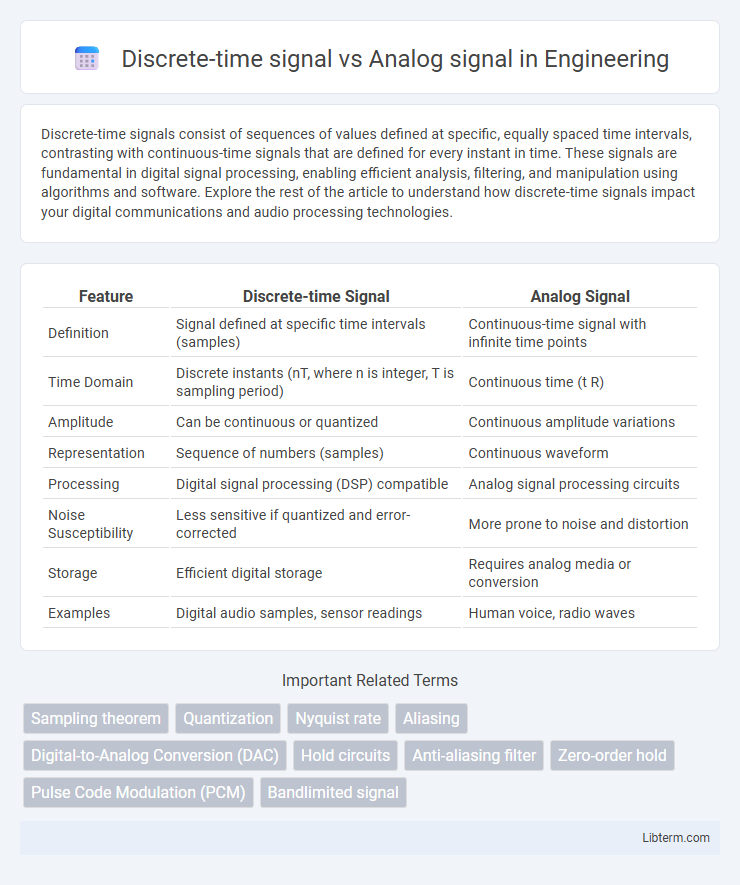Discrete-time signals consist of sequences of values defined at specific, equally spaced time intervals, contrasting with continuous-time signals that are defined for every instant in time. These signals are fundamental in digital signal processing, enabling efficient analysis, filtering, and manipulation using algorithms and software. Explore the rest of the article to understand how discrete-time signals impact your digital communications and audio processing technologies.
Table of Comparison
| Feature | Discrete-time Signal | Analog Signal |
|---|---|---|
| Definition | Signal defined at specific time intervals (samples) | Continuous-time signal with infinite time points |
| Time Domain | Discrete instants (nT, where n is integer, T is sampling period) | Continuous time (t R) |
| Amplitude | Can be continuous or quantized | Continuous amplitude variations |
| Representation | Sequence of numbers (samples) | Continuous waveform |
| Processing | Digital signal processing (DSP) compatible | Analog signal processing circuits |
| Noise Susceptibility | Less sensitive if quantized and error-corrected | More prone to noise and distortion |
| Storage | Efficient digital storage | Requires analog media or conversion |
| Examples | Digital audio samples, sensor readings | Human voice, radio waves |
Introduction to Discrete-Time and Analog Signals
Discrete-time signals consist of sequences of values defined at distinct, evenly spaced time intervals, commonly used in digital signal processing and communication systems. Analog signals vary continuously over time and can represent physical quantities such as sound, temperature, or voltage with infinite resolution. Understanding the fundamental differences between discrete-time and analog signals is essential for applications in electronics, control systems, and digital communications.
Definition of Discrete-Time Signals
Discrete-time signals consist of sequences of values recorded or defined at distinct time intervals, representing information as a series of numbers indexed by integers. Unlike analog signals, which vary continuously over time and can take any value within a range, discrete-time signals are inherently sampled and quantized for digital processing. These signals are fundamental in digital signal processing, enabling efficient storage, transmission, and analysis of real-world data in computing systems.
Definition of Analog Signals
Analog signals are continuous-time signals characterized by smooth, uninterrupted variations in amplitude over time, representing physical quantities such as sound, light, or temperature. These signals can take infinitely many values within a given range, enabling precise representation of real-world phenomena. In contrast, discrete-time signals are sequences of values sampled at specific intervals, which approximate analog signals for digital processing.
Key Differences Between Discrete-Time and Analog Signals
Discrete-time signals consist of values defined only at specific time intervals, whereas analog signals vary continuously over time. Discrete-time signals are typically represented by sequences of numbers suitable for digital processing, while analog signals are represented by smooth, continuous waveforms that capture real-world phenomena in real time. Key differences include sampling rate, quantization, and the necessity of analog-to-digital conversion for discrete-time signals to interface with real-world analog data.
Representation and Visualization Methods
Discrete-time signals are represented by sequences of values at specific time intervals, commonly visualized using stem plots or sampled graphs that highlight individual data points. Analog signals have continuous amplitude variations over time and are typically illustrated with smooth waveforms representing uninterrupted signal flow. Visualization methods for discrete-time signals emphasize distinct samples, while analog signals rely on continuous curves to depict their nature.
Applications of Discrete-Time Signals
Discrete-time signals are widely used in digital communication systems, where signals are sampled and processed for efficient transmission and error correction. They are essential in digital audio and video processing, enabling compression, filtering, and enhancement in devices such as smartphones, music players, and streaming services. In control systems, discrete-time signals facilitate real-time monitoring and automation by allowing microcontrollers and digital processors to analyze sensor data and execute precise commands.
Applications of Analog Signals
Analog signals are widely used in applications such as audio broadcasting, radio transmission, and analog video recording where continuous signal representation is crucial for capturing natural variations. Medical devices like electrocardiograms (ECG) and continuous temperature sensors rely on analog signals to monitor real-time physiological data with high fidelity. Industrial control systems also utilize analog signals for precise measurement and control of variables like pressure, flow, and temperature in manufacturing processes.
Advantages and Limitations of Discrete-Time Signals
Discrete-time signals offer precise digital representation and ease of processing, storage, and transmission compared to analog signals. Advantages include noise immunity, efficient data compression, and compatibility with modern digital systems. Limitations involve potential information loss due to sampling, aliasing effects, and finite resolution depending on sampling rate and quantization levels.
Advantages and Limitations of Analog Signals
Analog signals provide continuous representation of information, allowing smooth and natural variations ideal for audio and video transmissions. Their primary advantages include simplicity in capturing real-world phenomena and no requirement for sampling or quantization, preserving high fidelity. However, analog signals are prone to noise, distortion, and signal degradation over distance, limiting accuracy and requiring careful amplification and filtering for reliable communication.
Summary and Future Trends in Signal Processing
Discrete-time signals, represented by sequences of distinct values, contrast with continuous analog signals that vary smoothly over time, enabling digital systems to process, store, and analyze data more efficiently. Advances in signal processing focus on enhancing discrete-time algorithms for improved noise reduction, data compression, and real-time analysis, driven by machine learning and AI integration. Future trends emphasize the convergence of quantum computing and neuromorphic processors to revolutionize discrete-time signal processing, enabling ultra-fast, energy-efficient, and adaptive communication systems.
Discrete-time signal Infographic

 libterm.com
libterm.com